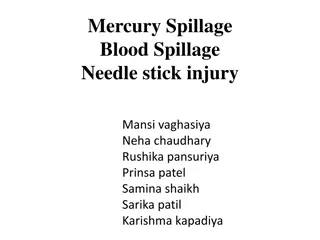Discovering Mercury: The Intriguing Innermost Planet of Our Solar System
Mercury, the closest planet to the Sun, is a fascinating world with unique characteristics. Despite being challenging to observe, Mercury shines brightly in the sky, boasting a coppery tinge and a temperature range from 193°C to 427°C. Its day is longer than its year, rotating 1.5 times each orbit. This small planet with an eccentric orbit provides valuable insights into the dynamics of our solar system.
Download Presentation

Please find below an Image/Link to download the presentation.
The content on the website is provided AS IS for your information and personal use only. It may not be sold, licensed, or shared on other websites without obtaining consent from the author.If you encounter any issues during the download, it is possible that the publisher has removed the file from their server.
You are allowed to download the files provided on this website for personal or commercial use, subject to the condition that they are used lawfully. All files are the property of their respective owners.
The content on the website is provided AS IS for your information and personal use only. It may not be sold, licensed, or shared on other websites without obtaining consent from the author.
E N D
Presentation Transcript
Mercury Mercury Written by David Ilsley Image: NASA public domain image collection
Mercury is the closest planet to the Sun at 0.4 AU. It is the least-often-spotted of the five naked-eye planets. This is because it is always close to the Sun in the sky, usually too close to be seen. It is visible for a few days just after sunset or just before sunrise when it is around its maximum elongation. Image: flickr.com
At its brightest, Mercurys magnitude is 2.48 compared to 1.46 for Sirius, the brightest star. So, Mercury is then about 2.5 times as bright as Sirius. It has a coppery tinge. Image: flickr.com
Jupiter Mars Moon This photo was taken at 5:30 am on 24 June 2022. Venus Mercury Image: flickr.com
Despite being the closest planet to the Sun, Mercury isn t the hottest. Its surface temperature ranges from 193 C to 427 C. Venus is a fairly constant 465 C all over. Image: flickr.com
Mercurys temperature range is so high for two reasons. 1. The sun is up (and very close) for 58 Earth days straight, so there is plenty of time in the Sun to warm up. Then it is night for 58 Earth days straight, so there is plenty of time to cool down. 2. There is virtually no atmosphere to absorb, store or move heat.
Mercurys day is 2 x 58 = 116 Earth days. Its year is 88 Earth days. So, its day is longer than its year. This is because it rotates 1.5 times each time it orbits the Sun. (Remember that, if it rotated once each time it orbited, its day would last for ever. It would be in a captured orbit with the same side always facing the Sun. If it rotated twice, its day would be the same length as its year.)
Mercury is the smallest planet, smaller than some solar system moons like Ganymede and Titan and not much bigger than our moon. Image: flickr.com
It also has the most eccentric orbit of the solar system planets, varying from 0.307 AU to 0.467 AU. The sunlight intensity doubles from aphelion to perihelion. Image: flickr.com
Mercury also has the smallest axial tilt of any planet at just 0.03 . Because the axial tilt is negligible, it does not cause seasons like it does on Earth. But the eccentricity of the orbit does, with the Sun providing twice as much heat at the hot time of the year. Image: flickr.com
Also, because of the negligible axial tilt, at the poles, the Sun s centre never gets more than 0.03 above the horizon. Though, because the Sun subtends an angle of 1.15 to 1.6 , its top gets up to 0.8 above the horizon. Image: flickr.com (cropped)
However, at the bottom of craters near the poles, no part of the Sun is ever visible. (although the ground would be somewhat illuminated by light that reflects off the crater rims.) Image: Picryl.com
Because of this, there is ice in the polar craters possibly around 0.1% of the ice in the Antarctic Ice Sheet on Earth. Image: flickr.com Considering that the Antarctic Ice sheet would cover much of one of the hemispheres of Mercury, that is quite a lot of ice.
Mercury is very cratered, indicating that its surface has not been renewed by volcanism or plate tectonics, at least since the very early years of the solar system when most craters were formed. Image: Wikipedia
In comparison to its size, Mercury has a very large core, making up over 60% of its volume as compared to 15% for Earth. Image: Wikimedia Commons
Image: .Wikimedia Commons (cropped) It consists of a solid iron inner core, a liquid iron outer core and a solid iron-sulphide layer above that. Then there is a silicate mantle (like Earth s) and a crust made from volcanic rocks which erupted from the then partially molten mantle in its very early history.
Image: .Wikipedia The liquid part of the core gives Mercury a dynamic magnetic field with a strength about 1% that of Earth s. This lower strength probably results from Mercury s slower rotation.
After Venus and Mars, Mercury is the closest planet to Earth. But it is the hardest to get to. This is because the gravity of the Sun causes a spacecraft to accelerate to a very high speed travelling from Earth to Mercury. A large amount of fuel is then necessary to decelerate to a speed which will allow the craft to orbit the planet. Image: StockSnap.io
Because of this, there have been only two missions to Mercury. Mariner 10 flew past in 1975 and MESSENGER went into orbit in 2011. Bepi Colombo is due to arrive in 2025. Image: .Wikimedia Commons
Of course, if we were happy just to smash into the planet at about 50 km/s, we wouldn t have to worry about the deceleration and the trip would be a lot easier. Image: .rawpixel
The End The End Image: NASA public domain image collection



![[PDF⚡READ❤ONLINE] Planet Mercury: From Pale Pink Dot to Dynamic World (Springer](/thumb/21549/pdf-read-online-planet-mercury-from-pale-pink-dot-to-dynamic-world-springer.jpg)



















